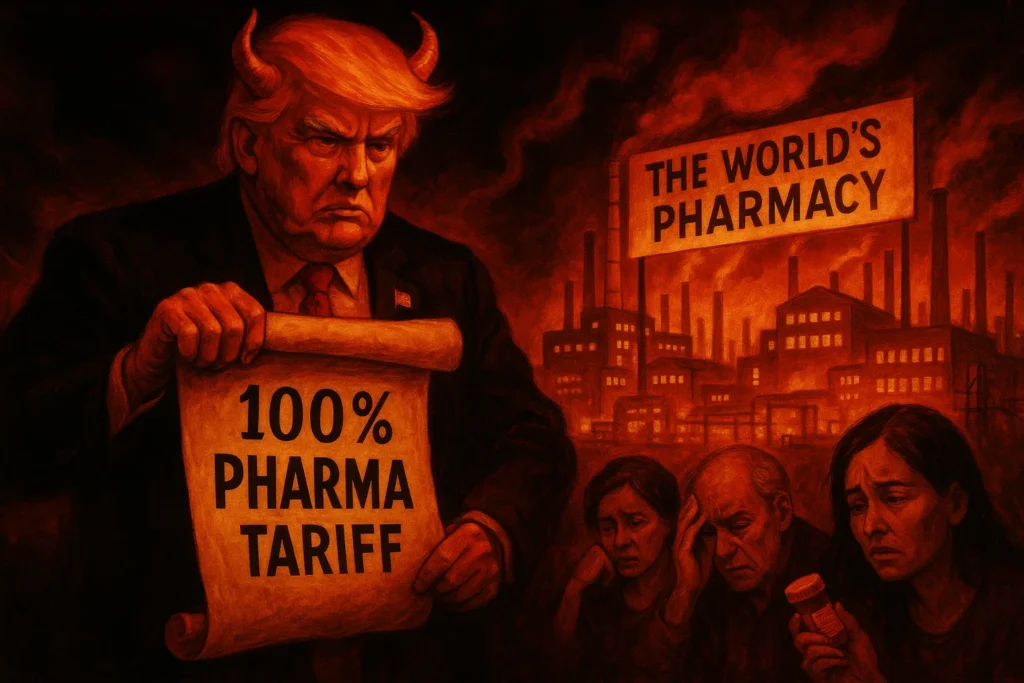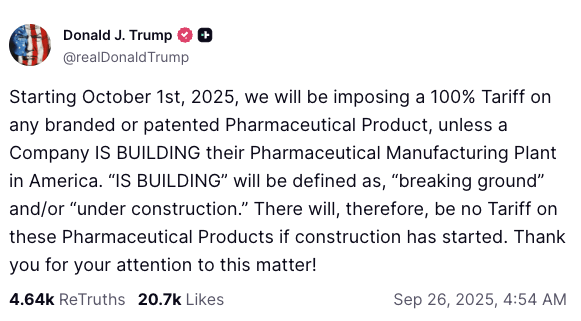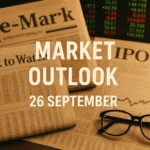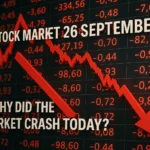Introduction- Trump’s 100% Pharma Tariff Effect
On September 26, 2025, Donald J. Trump set off ripples across global markets by announcing a 100% tariff on all branded and patented pharmaceutical imports into the U.S. The policy, slated to take effect on October 1, 2025, makes one exception: companies that have already started or are building manufacturing plants in America.
In Trump’s own words, “IS BUILDING” means breaking ground or having a site under construction. In practice, this means Indian pharma players with U.S. facilities are shielded, while those exporting directly from India face the heat.
The news sparked a 1.8% fall in the Nifty Pharma index, wiping out thousands of crores in investor wealth in just one session. Leading names like Sun Pharma (-2.45%), Zydus Lifesciences (-2.89%), and Divi’s Labs (-2.06%) saw steep drops, reflecting investor panic.
But here’s the critical question: Is this a real structural threat, or just another round of Trump’s political theatrics?
Nifty Pharma Reaction After Trump’s 100% Pharma Tariff Effect
| Name | LTP (₹) | Change % |
|---|---|---|
| Sun Pharmaceutical | 1,587.50 | -2.45% |
| Divi’s Laboratories | 5,775.50 | -2.06% |
| Cipla | 1,495.70 | -0.93% |
| Torrent Pharmaceuticals | 3,536.70 | +0.14% |
| Dr. Reddy’s Laboratories | 1,268.00 | -0.56% |
| Mankind Pharma | 2,479.00 | -1.87% |
| Zydus Lifesciences | 989.75 | -2.89% |
| Lupin | 1,944.30 | -0.98% |
| Alkem Laboratories | 5,458.50 | -0.90% |
| Aurobindo Pharma | 1,086.10 | -0.99% |
| Abbott India | 29,650.00 | -1.80% |
This knee-jerk reaction highlights investor nerves, but the real story lies in company-by-company exposure.
Company-Wise Exposure to the Trump’s 100% Pharma Tariff Effect
The tariff doesn’t hit everyone equally. Companies with U.S. plants are protected, while those without are directly in the line of fire. Here’s the breakdown:
| Company | U.S. Revenue Exposure | U.S. Manufacturing Status | Tariff Risk Level | Strategic Notes |
|---|---|---|---|---|
| Syngene | 68% | Biologics site (Baltimore) | Low | Exempt due to active U.S. site; mostly CDMO, not branded sales. |
| Gland Pharma | 54% | None | ▲ High | Pure injectables play; no U.S. site, at risk of pricing & market share erosion. |
| Biocon | 50% | Cranbury, NJ | Low | Branded biosimilars (insulin, trastuzumab) shielded by U.S. site. |
| Zydus Lifesciences | 45% | Berkeley & Emeryville | Low | CDMO biologics operations give exemption; branded risk minimal. |
| Dr. Reddy’s | 43–46% | NY site (limited) | Medium | Partial tariff shield; branded generics still exposed if not U.S.-made. |
| Glenmark Pharma | 46.5% | Monroe, NC | Low | Injectables and oral solids production protected by U.S. footprint. |
| Aurobindo Pharma | 45.3% | NJ sites | Low | Diverse portfolio with strong U.S. manufacturing shield. |
| Piramal Pharma | 41% | KY & MI CDMO sites | Low | CDMO model largely exempt; branded exposure minimal. |
| Lupin | 35–38% | FL & NJ sites | Low | Respiratory and biotech franchises shielded. |
| Sun Pharma | 30–33% | Billerica, MA | Low | Specialty products (Ilumya, Winlevi) exempt. |
| Cipla | 13–28% | Multiple U.S. sites | Low | Diversified portfolio shielded by U.S. presence. |
| Alkem | 20% | Enzene Biosciences | Low | Inhalers and oral solids exempt. |
Key Takeaways for Investors For Trump’s 100% Pharma Tariff Effect
1. The Outlier Risk: Gland Pharma
- With 54% revenue from the U.S. and no American facility, Gland is most exposed.
- Its injectables portfolio, already facing pricing pressure, could suffer volume loss and margin erosion.
- Unless it announces a U.S. plant or acquisition, the stock remains under serious tariff risk.
2. Partial Risk Zone: Dr. Reddy’s
- Though it has a New York site, it’s limited in capacity.
- Its branded generics pipeline may still face tariffs if not locally produced.
- Investors should brace for some margin hit until clarity emerges.
3. The Protected Pack
- Sun Pharma, Cipla, Lupin, Biocon, Aurobindo, Zydus, Piramal, Glenmark — all enjoy strong protection due to U.S. facilities.
- These names will see lesser long-term impact, and may even gain market share if competitors like Gland falter.
4. CDMO Advantage
- Syngene and Piramal are the least exposed.
- As contract manufacturers, their model is service-based and shielded from tariffs. Expect valuation premiums to expand here.
Beyond the Headlines: Why India Still Holds the Edge After Trump’s 100% Pharma Tariff Effect
The initial knee-jerk market reaction to Trump’s tariff drama made it seem like the Indian pharma story is under threat. But peel back the noise, and the fundamentals tell a very different story.
India is not just another player in global pharmaceuticals — it is the backbone of affordable healthcare worldwide.
- Generics powerhouse: Nearly 40% of generic drugs consumed in the U.S. are manufactured in India. Without these imports, U.S. patients would face a massive healthcare affordability crisis.
- Vaccines leader: Over 60% of the world’s vaccines come from India. Whether it’s polio eradication, COVID-19 immunization, or HPV prevention, India’s role is irreplaceable.
- Biosimilars edge: Indian companies like Biocon and Zydus have made advanced biologics affordable. A drug that costs $50,000 per year in the U.S. can be accessed for a fraction of that thanks to Indian biosimilars.
Now consider this: A 100% tariff does not eliminate India from the supply chain. Instead, it simply doubles the price for American patients. For example:
- A $100 vial of insulin imported from India would now cost $200 in the U.S.
- The same insulin, if manufactured locally in the U.S., may cost $350–400 because of higher labor and facility costs.
This creates a paradox: tariffs hurt Americans far more than Indians.
And let’s not forget the political angle. While Trump may use this drama to rally voters, the U.S. healthcare lobby is powerful. Insurers, hospitals, and patient advocacy groups will push back strongly if medicine prices shoot up. Over time, these tariffs could face dilution, exemptions, or reversals.
For India, the message is simple: We remain the pharmacy of the world — cheap, effective, trusted.
Investor Outlook: Short-Term Pain, Long-Term Gain
From an investor’s perspective, this episode offers valuable lessons:
1. Short-Term: Expect Knee-Jerk Volatility
- Until October 1, uncertainty will keep pharma stocks choppy.
- Gland Pharma (no U.S. site) and Dr. Reddy’s (limited U.S. footprint) may remain under selling pressure.
- Sentiment-driven declines could present buying opportunities in fundamentally strong counters.
2. Medium-Term: Capex & Strategic Acquisitions
- Indian pharma has deep pockets. Expect new U.S. manufacturing announcements — greenfield plants, expansions, or outright acquisitions.
- Example: Lupin and Sun Pharma have a history of U.S. M&A, and this tariff could accelerate similar moves.
- Such investments will not only protect margins but also enhance long-term credibility with regulators.
3. Long-Term: India’s Growth Story Intact
- Demographics: Ageing U.S. and European populations ensure rising demand for generics and biosimilars.
- Healthcare cost pressure: Western governments cannot afford expensive branded drugs — they need Indian cost efficiency.
- Innovation: Indian players are increasingly moving into specialty therapies (oncology, respiratory, dermatology).
For investors, the strategy is clear:
- Accumulate “shielded” companies with U.S. manufacturing bases (Sun, Cipla, Lupin, Biocon, Aurobindo, Zydus).
- Play the CDMO theme (Syngene, Piramal) — these service-based models are tariff-proof and enjoy structural tailwinds.
- Be cautious with unprotected names like Gland Pharma unless they announce corrective steps.
In other words, this is a stock-picker’s market within pharma, not a blanket negative for the sector.
Final Word: A Drama-Filled Disruption That Strengthens India
Trump’s September 26 announcement is headline-grabbing, dramatic, and intentionally disruptive — but it does not rewrite the fundamentals of the pharma world.
- For Indian exporters, the effect is selective, not universal. Most large players are protected through U.S. plants.
- For American patients, the pain will be real: higher costs, squeezed insurers, and mounting political pressure.
- For investors, this is not the end of the India pharma growth story — it’s simply a temporary speed bump.
If anything, this episode will:
- Accelerate Indian companies’ localization strategy in the U.S.
- Reinforce India’s global positioning as a low-cost, high-quality medicine hub.
- Create buying opportunities in high-quality pharma stocks.
At the end of the day, Trump’s 100% pharma tariff effect is less about economics and more about political optics.
India remains what it has always been — the world’s pharmacy. And no tariff, however dramatic, can change that.
FAQs on Pharma Tariff Effect
1. What is the Pharma Tariff Effect?
The Pharma Tariff Effect refers to the impact of Donald Trump’s announced 100% tariff on Indian pharmaceutical imports into the U.S., effective from October 1, 2025. It mainly affects companies that export directly from India without U.S.-based manufacturing units.
2. Which Indian pharma companies are most exposed to the Pharma Tariff Effect?
Companies like Gland Pharma face the highest risk since they lack a U.S. manufacturing base. Others, such as Dr. Reddy’s, may see partial exposure. However, most large players like Sun Pharma, Cipla, Lupin, Biocon, and Zydus are well shielded through U.S. facilities.
3. Why did NIFTY Pharma drop after the announcement?
The NIFTY Pharma Index fell 1.80% on the announcement day (September 26, 2025) due to investor panic and fear of export losses. Stocks like Zydus (-2.89%), Sun Pharma (-2.45%), and Divi’s Labs (-2.06%) saw sharp declines.
4. Will Indian pharma exports to the U.S. decline significantly?
Unlikely. India is already the “pharmacy of the world”, supplying nearly 40% of U.S. generics. While tariffs may raise costs for American patients, Indian companies with U.S. facilities can bypass these duties. Exports from India may shift towards local U.S. production rather than declining outright.
5. What does the Pharma Tariff Effect mean for U.S. patients?
For American consumers, the Pharma Tariff Effect means higher medicine costs. A 100% tariff essentially doubles the landed price of drugs imported directly from India. This could make healthcare more expensive without reducing reliance on Indian suppliers.
6. Is this tariff a long-term structural risk or short-term political drama?
Experts see this more as political drama ahead of U.S. elections. In the long run, India’s pharma sector is resilient because of its cost advantage, quality, and global trust. Tariffs may temporarily shake stock prices, but India’s pharma growth story remains intact.
7. How should Indian investors view the Pharma Tariff Effect?
For investors, the Pharma Tariff Effect is likely a short-term sentiment-driven dip rather than a fundamental challenge. In fact, corrections could open buying opportunities in frontline pharma stocks with strong U.S. presence.
Related Articles
Trump’s Tariff Shockwave: How Indian Stocks & Sectors Will Be Hit or Rise





